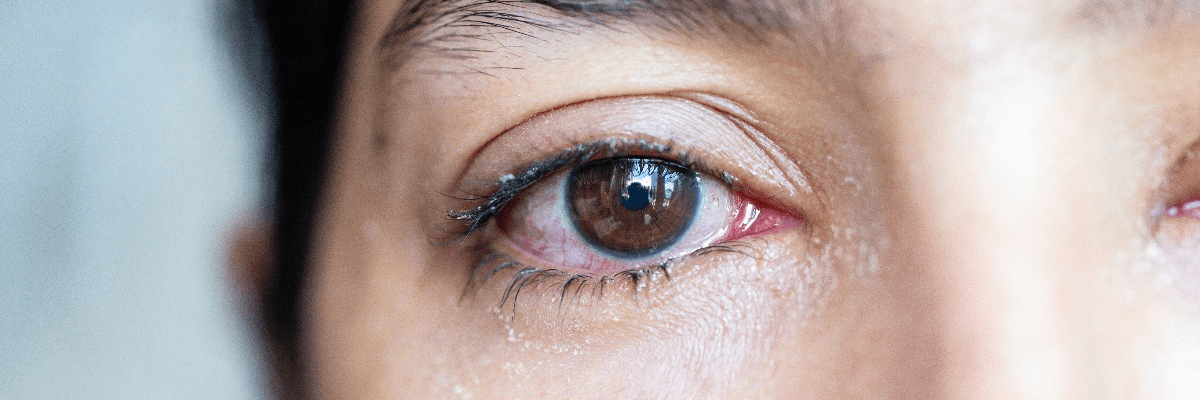Unexpected Dry Eye Symptoms to Watch Out For
You may believe that to have Dry Eye disease, the symptoms you should be looking out for are dry, itchy or irritated eyes. However, the symptoms can be more complex than this, and you may be experiencing Dry Eye without realising it.
What is Dry Eye Disease?
Dry Eye Disease is a very common condition. ¼ of all people suffer from the condition in the UK. [1] Across the world, it affects tens of millions of people. [2]
Dry Eye can appear in several forms. Aqueous Deficient Dry Eye is when inflammation in your lacrimal gland prevents it from producing enough aqueous tears.
Evaporative Dry Eye is caused by Meibomian Gland Dysfunction where the glands that produce the outer, oily layer of your tear film don’t work properly. This means your tears aren’t able to adequately lubricate your eye.
Mixed Dry Eye is a combination of aqueous tear deficiency and tear instability, meaning your eyes produce fewer tears and the tears that are produced have an unstable tear film. [2]
Other conditions can also cause many Dry Eye symptoms so it’s important to talk to your GP if you’re worried.

The Dry Eye symptoms you may be familiar with
You could have Dry Eye if you are experiencing:
- A scratchy feeling, like there’s something in your eye
- Stinging or burning feelings in your eye
- Red eyes
- Sore or aching eyes
- The feeling of sand or grit in your eyes
- Blurry vision [3]
But there is a more expansive list of symptoms that you may not have considered. Keep reading to learn what these are and what you can do if you believe you’re struggling with this condition.
Unexpected and unusual symptoms of Dry Eye
As well as the feeling of dry, itchy, discomfort in your eyes, you might experience several different symptoms.
Watery Eyes
It might sound contradictory, but excess tears and watery eyes can also be a symptom of Dry Eye disease. The condition is caused by a lack of quality tears – not an absence of the production of them. This means that when the eye is not lubricated well enough and becomes dry, tear production can be overstimulated leading to watery eyes. [4] You might notice a similar response in situations like the cold or wind when the ends tend to water more. [5]
Unlike when you suffer a cold or an injury, excess tears are produced with Dry Eye because when the meibomian glands are producing enough oils for the outer layer of the tear film, the middle layer of your tear film evaporates too quickly. This causes the lacrimal glands to make more tears to compensate. However, without the oil the tears aren’t able to coat your eye, meaning they remain dry. [2]
However, watery eyes can also be caused by blocked tear ducts, an allergy, Bell’s Palsy, or other conditions so it’s important to protect your eyes, monitor the condition, and reach out to your GP if your eyes watering is affecting your everyday activity. [5]
Red Eyelid Rims
If you’re noticing redness on your eye margins or small bumps, you should be aware that it could be an indication of Dry Eye. Red eyelid rims can be signs of Blepharitis or Meibomian Gland Dysfunction, which can cause Dry Eye disease. It’s important not to ignore this sign and to seek help or treatment as Blepharitis can lead to blurred vision. [6]
Puffy Eyes
Most people will experience puffiness in their eye area at certain times. Allergies, poor sleep, and poor diet can all cause temporary puffiness. However, in combination with other symptoms, it might be a sign of Blepharitis – inflammation along the edge of the eyelid. [7]
This condition has been associated closely with Dry Eye disease. Find out more about Blepharitis and Dry Eye in our article – read the blog here.
Light Sensitivity
Are you feeling particularly sensitive to the sun in the morning? Can’t look at a TV with full brightness? A sensitivity to light (photophobia) can actually be a symptom of Dry Eye Disease. [8]
The uncomfortable or sometimes painful response to sunlight or indoor lighting can be caused by eye irritation. Dry Eye irritates your eyes, making them more susceptible to reactions like this.
If light sensitivity is affecting your life, consider wearing sunglasses more frequently outdoors, and see your optician to discuss your optical health.
Eyelid Twitching
If you’re feeling twitchy – don’t panic. While eyelid twitching can be irritating it is a common condition. Eyelid Myokymia can be triggered by dry and irritated eyes, meaning it can often be a symptom of Dry Eye disease.
Ocular Fatigue
Ocular fatigue or eye strain is primarily associated with activities like reading, writing, driving, playing video games, or staring at screens. [9] However, it also has a very strong correlation with Dry Eye. One study showed that 51.4% of patients who reported symptoms of ocular fatigue were also diagnosed as having Dry Eye with symptoms. [10]
No Symptoms
This unexpected symptom of Dry Eye might seem confusing, but some patients with Dry Eye disease exhibit no symptoms at all. Advanced technology can actually identify, diagnose, and treat Dry Eye before patients start exhibiting symptoms. [6]
Can Dry Eye symptoms come and go
When it comes to Dry Eye you may notice that certain times are worse for your symptoms than others. These are called flare-ups. You may notice a worsening of your symptoms during different seasons, in certain environments, or even just if you’ve been exposed to an allergen.
The symptoms you’re experiencing can also change over time. It’s important to keep an eye on what symptoms you’re experiencing, in case they’re related to a more serious condition as certain eye problems can impair your vision. [11]
Dry Eye disease can be a chronic condition for many people. Symptoms may improve with treatment but flare-ups will continue to occur throughout your life. For others though it can be temporary. After making lifestyle adjustments like refraining from extended computer use and stopping smoking, you might notice symptoms disappear over time. [11]
While Dry Eye symptoms can be varied, it’s usually a very manageable condition. With the right treatment like hydrating eye drops, you can relieve symptoms easily and live a very fulfilling life.
If you’d like more advice on Dry Eye, feel free to reach out to our community on Instagram (@dryeyeandme) and Facebook (Dry Eye and Me) or get in touch with us.
If you’re looking for products to aid with your Dry Eye symptoms then visit VISUshop which has a wide range of eye drops and other products to help improve your health and wellbeing – https://visushop.co.uk/.
References
- Visual Answers Optometrists, ‘Dry Eye’, Last Accessed February 2024
- Cleveland Clinic, ‘Dry Eye’, Last Accessed February 2024
- Dry Eye and Me, ‘Dry Eye Symptoms’, Last Accessed February 2024
- Premier Health, ‘Strangely Enough, Teary Eyes a Sign of Dry Eye’, 21/12/21, Last Accessed February 2024
- NHS, ‘Watering Eyes’, Last Accessed February 2024
- Koutsokeras, Alex, ‘15 Unusual Signs and Symptoms of Dry Eyes’, 05/04/2022, Last Accessed February 2024
- Mayo Clinic, ‘Blepharitis’, 10/05/2022, Last Accessed February 2024
- Specsavers, ‘Photophobia (Light Sensitivity), Last Accessed February 2024
- Ansorge, Rick, ‘13 Tips to prevent Eye Fatigue’, 21/02/21, Last Accessed February 2024
- Toda, I, et al, ‘Ocular Fatigue is the Major Symptom of Dry Eye’, Act Ophthalmologica vol, 71,3 (1993), Last Accessed February 2024
- Cafasso, Jacquelyn, ‘Your FAQs, Answered: Can Dry Eyes Be Cured?’, 29/06/23, Last Accessed February 2024





